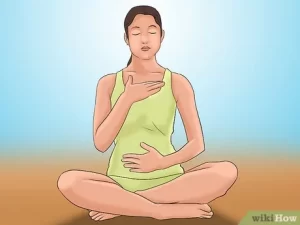
There is great diversity, malleability, and richness in the term yoga. The meaning of yoga depends significantly on the context and who you ask.
James Nestor, who is the author of the New York Times Bestseller book Breath, commented that “Yoga is the science of increasing and maintaining lung capacity.”
You may be wondering why increasing our lung capacity matters. And what does this have to do with yoga?
In today’s blog post, we will discuss the importance of the breath and how to use postural yoga to facilitate a beneficial breathing pattern.
Modernizing an Ancient Practice

Exercising our lungs helps to increase and maintain lung capacity, which has physiological and psychological benefits. When we make an automatic, unconscious act, conscious we can effect change and move toward living a longer, happier, and healthier life.
Humans discovered thousands of years ago that they could hack their bodies with their breath. Different cultures have talked about, practiced, and studied conscious breathing for thousands of years. They all reached the same conclusion- If we breathe improperly our health suffers. If we breathe properly, we can heal ourselves.
In today’s modern world, we now have the technology to study breathing to prove how it’s working. Researchers are now confirming the many benefits of conscious breathing. Some instruments let us observe how the breath can alter our moods and bodies. For instance, biofeedback allows us to see how changing the breath can bring blood pressure up or down in a matter of minutes.
With proper breathing, we can willingly function in a different way that is beneficial to our health. We can’t take conscious control of our heart rate, circulation, liver function, or digestion. What we can do is take control of our breath which influences all of these functions.
Making an Unconscious Act Conscious

Humans take around 25,000 breaths per/day. We breathe without even thinking about it. A bit of deliberate practice can yield some dramatic benefits.
According to Nestor, increased lung capacity can help us live a longer and healthier life. Multiple studies found that the most accurate marker of health and longevity is not determined by our genes or cardiovascular health. Instead, people with greater lung capacity and respiratory health tend to be healthier and live longer.
Lung capacity is important because if we have larger lungs we can take fewer breaths and breathe more efficiently. This results in a slower heart rate and decreased blood pressure.
Like most things in life, there is good news and bad news about these findings. The bad news is, that we naturally lose lung capacity as we age. Between the ages of 30-50, we lose about 12-15% of our lung capacity. Lung capacity further decreases as we get even older.
The good news is, that we can increase our lung capacity and improve our respiratory health at any age.
How Breathing Practices Improve Lung Capacity & Health

Modern Science has affirmed that breathing has a “sweet spot” where the breather can get physiological and psychological benefits. These benefits arise when we breathe around 6 breaths per/minute. This type of slow breathing is referred to as Resonance Frequency Breathing.
Resonance Frequency Breathing is slow, deep, relaxed, diaphragmatic breathing at a rate of around 3-7 breath cycles per/minute. Not only does this pattern of breathing improve lung function and respiratory health, but it also has a regulatory effect on the Anatomic Nervous System (ANS) and other key systems of the body.
The benefits of Resonance Frequency Breathing include:
- Helps expand your lungs, improves gas exchange, and increases efficiency in oxygen absorption and supply
- Calms the sympathetic nervous system (flight or fight response) helping to reduce stress
- Helps activate the parasympathetic nervous system (rest and digest) resulting in a calmer state of mind, and aids in the healing process
- Allows our respiratory, cardiovascular, and nervous systems to work together in a synchronized manner so they can function more efficiently
- Slow breathing synchronizes with brain rhythms which are associated with pleasant mood states
- Helps people with depression, panic disorders, anxiety, and mood disorders
- Assists in the control of blood pressure and heart disease
- Improves symptom control, asthma, and COPD
- Reduces inflammation
Research on Resonance Frequency Breathing has only gone on since the 1990s. However, humans have instinctively known about this type of breathing pattern for centuries. Speech patterns that produce this resonant frequency are present in hymns, chants (OM), prayers, and poetry.
According to Nestor, “When Buddhist monks chant their most popular mantra, Om Mani Padme Hum, each spoken phrase lasts six seconds, with six seconds to inhale before the chant starts again… Japanese, African, Hawaiian, Native American, Buddhist, Taoist, Christian—these cultures and religions all had somehow developed the same prayer techniques, requiring the same breathing patterns. And they all likely benefited from the same calming effect.”
How Yoga Assists With Slow, Deep, Breathing

Movement is one way we can stimulate a Resonant Frequency pattern of breathing. Yoga is an intelligent system that links movement, eye gaze, and breath to help us achieve neuroplastic changes in our pattern of breathing.
There is a natural linking and relation of breathing, posture, eye gaze, and movement. For example, looking up, extending the spine, and slightly dropping the head back facilitates inhalation. Looking down, flexing the spine, and bringing our chin towards our chest facilitates exhalation.
Many of the yoga postures are practiced with a slow inhale on the rising movement followed by a slow exhale for the lowering one. Your body understands the symmetry of the movements and transfers that balance to the breath.
How Yoga Increases Lung Capacity

A yoga practice consists of a range of postures that require us to bend, fold, expand, and twist. We can breathe into the whole 360-degree circumference (lateral, vertical, posterior, and anterior directions) of the rib cage and abdomen as we move through these various postures. These different movements ensure that we are not just breathing into the chest or the belly, but also expanding our breath into our side and back body.
According to the Clevland Clinic, “When you breathe normally, you don’t use your lungs to their full capacity. Diaphragmatic breathing allows you to use your lungs at 100% capacity to increase lung efficiency.”
Breathing into the whole circumference of the upper rib cage, lower rib cage, and abdomen can help us activate and engage the diaphragm. Diaphragmatic breathing can increase our lung capacity and improve respiratory health.
Bottom Line

Breathing is more than an automatic biological function that we depend on to survive. It is also a very useful tool for healing the body and focusing the mind. Breathing is unique because we cannot control many of our bodily functions. But we can control our breathing to affect healthier physiological and psychological states of being.
The first step to breathing better is to be conscious of it. Then we can adopt and apply simple healthy breathing habits to transform our health. Below are some ways to incorporate slow, deep, relaxed breathing into your daily life.
Action Points

Here are simple ways to work on Resonant Frequency Breathing
Becoming aware of your breath is the first step. Start by paying attention to your breath. Slow the breath down until it feels comfortably slow. We start to breathe deeper just by slowing the breath down.
Find a soothing and relaxing rhythm of breathing in and out. See if you can breathe in for a count of 5 and breathe out for a count of 5. Adjust the duration of your breath if this pace feels uncomfortable. Try not to over-control your breath. You want each cycle of breath to feel soft or relaxed, not strained or forced. Repeat this pattern of breathing for as many rounds as possible.
We can practice Resonant Frequency Breathing while driving, doing dishes, walking around the house, before you go to bed, during yoga, or any other time you can focus your mind on slow, deep, soft rhythms of breath.
The app Breathing Zone can also be used to count breath cycles. It automatically sets your target breathing rate and slows the pace of your breathing.
Here are three simple guidelines for pairing slow, deep, relaxed breaths with different yoga poses (asanas)
- When bending forward, look down, and slowly exhale.
Exhalations empty the lungs, making the torso more compact resulting in less physical mass between our upper and lower body as they move toward each other. The heart rate also slows down during the exhalation.
We can link our exhalations to asanas that require us to forward bend. These include poses such as seated forward fold, pigeon pose, or standing splits.
Forward bends are grounding and calming postures. Linking them with a long, slow breath out increases the calming effect of the pose since exhalations stimulate the parasympathetic nervous system.
Once in the pose, think about directing slow, deep, relaxed breaths into the back/posterior aspect of your body.
- When lifting or opening the chest, look up, and slowly inhale.
Inhalations expand the chest and abdomen. When we inhale and open the chest, we increase the space in our chest cavity, giving the lungs, rib cage, and diaphragm more room to fill with air. Our heart rate speeds up on an inhalation, increasing alertness and pumping more blood into muscles.
We can link our inhalations to movements or asanas that open the front body. These include backbends, raising the head, and raising the arms.
Front body openers have an energizing effect. Linking them with a deep, slow breath in increases the energizing effect of the pose since inhalations stimulate the parasympathetic nervous system.
Once in the pose, think about directing slow, deep, relaxed breaths into the front/anterior aspect of your body.
- When twisting or side bending, inhale to prepare, then slowly exhale.
Twists and side bends restrict the expansion of the chest and abdomen. The inhalation accompanies the preparation phase of the twisting or bending pose (lengthening the spine, etc.), and the exhalation is paired with the twisting or bending action. Posturally, that’s because as our lungs empty there’s more physical space available for our rib cage to rotate further.
Twists are also known for their detoxifying effects, and linking these poses with an exhalation helps the body expel CO2.
Once in the pose, think about directing slow, deep, relaxed breaths into the sides/lateral aspect of your body.
- Let the breath be your guide as you breathe slowly, deeply, and effortlessly in each pose.
The breath should serve as a guide in all poses. If the breath becomes strained or disturbed, this may be a signal that the body’s been pushed too far. You can adjust your pose by backing off or modifying it. Then return to a slow, controlled rhythm of breath.
Learn More








